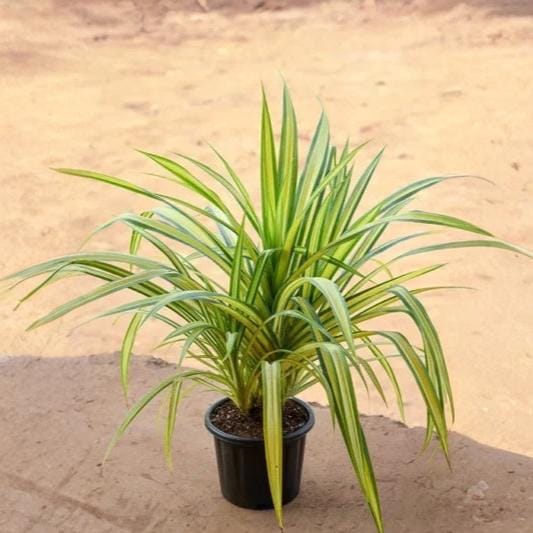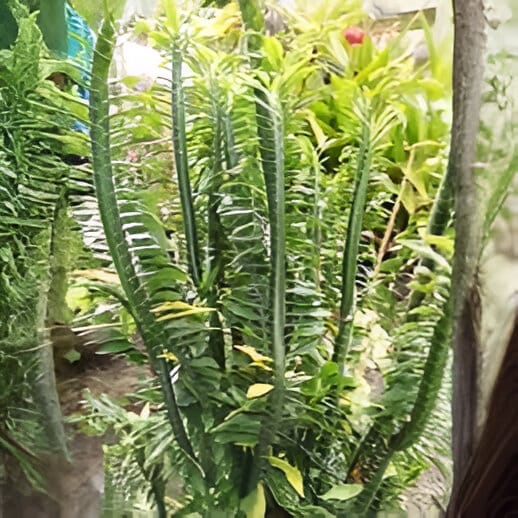

pedilanthus plant
₹199.00 Original price was: ₹199.00.₹149.00Current price is: ₹149.00.
Details:
The Pedilanthus is a unique and visually striking plant, perfect for adding an exotic, sculptural element to your home or garden. Its angular stems, colorful flowers, and bold growth habit make it an eye-catching focal point. It’s relatively easy to care for, as long as you provide it with proper lighting, well-draining soil, and moderate watering. With its unique appearance and low-maintenance care, Pedilanthus makes an excellent choice for both novice and experienced plant enthusiasts.
Description
Pedilanthus is a genus of flowering plants belonging to the Euphorbiaceae family, commonly known as the spurge family. Known for its unique and striking appearance, Pedilanthus is sometimes referred to as “Devil’s Backbone” or “Red Dragon” due to its unusual, often colorful, and angular stems. It is typically grown as an ornamental shrub or small plant. Here’s a detailed description:
- Scientific Name: Pedilanthus (several species, with Pedilanthus tithymaloides being one of the most commonly cultivated).
- Common Names: Pedilanthus, Devil’s Backbone, Red Dragon, Slipper Plant
Appearance:
- Leaves: The leaves of Pedilanthus are typically oval, lance-shaped, and can have a smooth or slightly wavy texture along the edges. They are usually medium to dark green and have a slightly waxy texture. The leaves grow alternately along the stems and are quite attractive, especially when combined with the plant’s bold stems.
- Stems: One of the most unique features of Pedilanthus is its angular, zigzagging stems that give it a distinctive, sculptural look. The stems can be green, and as the plant matures, they can develop a reddish or purple tint, adding to the plant’s ornamental value. The stems often appear jointed and twisted, contributing to the plant’s “devil’s backbone” appearance.
- Flowers: Pedilanthus produces small, tubular flowers that are often brightly colored, typically in shades of red, pink, or orange. These flowers have a distinctive shape, resembling a slipper or boot, which is the reason for its common name “Slipper Plant.” They are typically borne in clusters at the tips of the stems or leaf axils. The flowers attract pollinators like hummingbirds and butterflies.
- Size: Pedilanthus is a relatively small plant that can grow to about 3 to 4 feet (90 cm to 1.2 meters) tall in optimal conditions. Its bushy nature and branching habit make it an interesting focal point in gardens, especially when grown in pots or containers.
Growing Conditions:
- Light: Pedilanthus thrives in bright, indirect light but can tolerate some direct sunlight, especially during the early morning or late afternoon hours. If grown in too much shade, the plant may become leggy and its growth may slow. To keep it compact and full, provide ample light.
- Temperature: This plant is native to tropical and subtropical regions, so it enjoys warm temperatures, typically between 65°F to 85°F (18°C to 29°C). It does not tolerate frost, so it should be protected from cold weather. In colder climates, Pedilanthus is often grown as a houseplant or in containers.
- Soil: Pedilanthus prefers well-draining soil. A cactus or succulent mix works well, as it does not like to sit in overly moist soil. Slightly acidic to neutral soil is ideal for healthy growth.
- Humidity: Being a tropical plant, Pedilanthus enjoys moderate to high humidity but can tolerate average indoor humidity. To encourage optimal growth, occasional misting or placing the plant on a humidity tray can be beneficial in dry climates.
Care:
- Watering: Pedilanthus requires moderate watering. It’s important to let the top inch or two of soil dry out before watering again. Overwatering can lead to root rot, so be sure not to let the plant sit in stagnant water. During the winter months, reduce watering as the plant’s growth slows down.
- Fertilizing: During the growing season (spring and summer), feed Pedilanthus with a balanced, diluted, liquid fertilizer once a month to encourage healthy growth and blooming. In fall and winter, reduce the frequency of fertilizing.
- Pruning: Regular pruning helps keep Pedilanthus bushy and compact. You can trim back the stems if they become too long or leggy. Pruning will also encourage the plant to produce more side shoots, which will result in a fuller and more attractive plant.
Pests and Problems:
- Pests: While Pedilanthus is generally pest-resistant, it can sometimes attract common indoor pests such as mealybugs, scale insects, and spider mites. Keep the plant clean and inspect it regularly for pests. Wiping the leaves and stems with a damp cloth can help prevent infestations.
- Diseases: Overwatering or poor drainage can lead to root rot or fungal infections, especially in humid environments. Make sure the plant has proper drainage and avoid letting it sit in waterlogged soil.
Toxicity:
Pedilanthus is toxic if ingested due to the presence of a milky latex sap in the plant’s tissues. This sap can cause skin irritation, so it’s important to handle the plant with care and wear gloves when pruning or repotting it. Keep the plant out of reach of children and pets, as ingestion of any part of the plant can cause gastrointestinal distress.



Reviews
Clear filtersThere are no reviews yet.